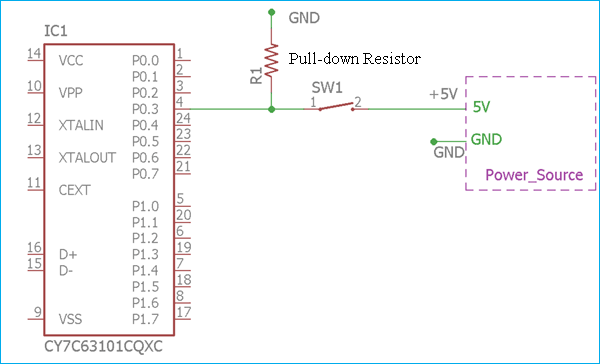Hi, all. I'm really new to electronics, and I'm hoping to check my understanding of how pull-up and pull-down resistors work, especially when the switch (or whatever else) is open. Please let me know where I'm right and where I could understand better.
The basic idea is that if you don't have a pin on an IC connected to anything else in the circuit, you don't what the voltage (a.k.a. potential difference) between that pin and V
cc or ground are, so weird things might happen.
To avoid weird things, you put a resistor in parallel with the switch (or whatever else), which pulls the voltage at the pin close enough to V
cc or ground when it would otherwise float that it might as well be V
cc or ground. A pull-up resistor is connected to V
cc and causes the pin to be ≈V
cc when the switch is open; a pull-down resistor is connected to ground and causes the pin to be ≈0 when the switch is open. (As a result, an open switch causes a high voltage on the pin with a pull-up resistor and a low voltage with a pull-down resistor.)
Why that works is where I'm having a hard time. This all seems to depend on the current over the IC pin being "small." This may seem like an obvious question, but the current over two things that "consume" power in series has to be smaller than the current of either on its own, right? So the current of the IC on its own is the upper bound for the current of the IC in series with the resistor?
In
this example from Circuit Digest, when the switch is closed, the voltage is =5v because voltage is the same in parallel. When the switch is open, because current is small, the voltage drop across the resistor is ≈0, so the voltage on the IC-side of the resistor is ≈0, so the voltage at the pin is pulled down to V≈0. Does that sound about right?

Similarly, with a pull-up resistor, as in this example from
The Mad Science Notebook, closing the switch makes the pin's voltage =0v because voltage is the same in parallel. Does this also mean that all of current is being dissipated as heat by the resistor? (Except for the negligible current going through the IC because electricity is complicated?) The power of that heat would be very little because of the numbers involved, but not zero. And when the switch is open, because the IC uses very little current, the voltage drop is over the pull-down resistor is ≈0, so at the pin, V≈V
cc.

I've read in a bunch of places that a 10kΩ is kind of standard. The reason why it can't be arbitrarily small is obvious; you'd be effectively shorting V
cc to ground. Is the reason it can't be arbitrarily large because then V≈0 starts to become V≫0? Basically, you need to make sure the smallness of the current that the IC uses at V
cc can "overwhelm" the chosen bigness of the resistivity of the resistor. I know that's not the most technical language, as an intuitive understanding, is it correct?
I read also that there's something about
how the resistivity affects the speed of the pin moving between V
cc and ground.
I'm looking forward to asking more questions in the future!